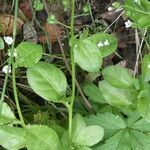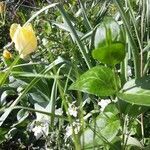Plants annual, glabrous. Stems erect, 10--30(--40) cm, terete or obscurely angular. Basal leaves obovate to oblong-ovate, 1.2--6.5 X 0.7--3 cm, tapering to base forming a short winged petiole, margin entire, apex rounded to obtuse. Stem leaves smaller, short petiolate or sessile, apex obtuse to apiculate. Racemes loose, usually 8--20 cm, 10--20-flowered. Pedicel 6--12 mm; bracts lanceolate, ca. 1 mm, adnate to middle of pedicel. Calyx campanulate, ca. 1 mm, enlarging to 2--2.5 mm in fruit, parted to 1/3; lobes triangular. Corolla white, 2--3 mm in diam.; tube nearly as long as calyx; lobes ovate, apex obtuse. Capsule 2--3 mm in diam. 2n = 24, 26.
A low creeping herb which continues to grow from year to year. It grows 10-40 cm high. The stems may or may not be branched. The leaves are oval or spoon shaped. They are pale green in a ring near the base. The leaves up the stem are alternate. The flowers are white and cup shaped. They are 2-3 mm across. They are on loose racemes. The petals are joined for half their length.
Lowest stem leaves 5 cm. long or less, spathulate to suborbicular with a– short petiole; upper leaves decreasing in size, becoming bractiform, elliptic, sessile.
Stamens 5, c. 1 mm. long, inserted at the base of the corolla–tube; staminodes 5, subulate, inserted in the corolla–tube between the lobes.
Racemes many–flowered; pedicels with bract c. 1 mm. long inserted at or above the middle.
Calyx cup–shaped, with tube c. 1–5 mm. long and triangular lobes c. 1/ as long as tube.
Basal leaves up to 10 x 3 cm., fleshy, spathulate, tapering at the base into a petiole.
Corolla c. 2 mm. long, white, subcampanulate, with broadly spathulate lobes.
Capsule c. 3 mm. long, globose; valves strongly reflexed after dehiscence.
Seeds 0·3–0·6 mm. long, ± tetrahedral, minutely granular, dark brown.
Stems erect, simple or branched, leafy, arising from a basal rosette.
Glabrous annual herb up to 50 cm. tall.
A glabrous herb 1-3 ft. high
Style c. 0–5 mm. long.
Small white flowers













